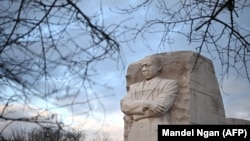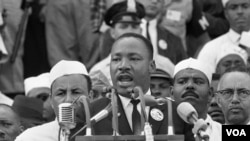King was assassinated more than half a century ago on April 4, 1968. Here are some key facts about his life.
Early life
Martin Luther King Jr. was born Michael King Jr. on Jan. 15, 1929, in Atlanta, Georgia. He was the son of Michael King Sr., a prominent local preacher and civil rights leader, and Alberta King, a former schoolteacher. When he was 28 years old, King’s father legally changed their names to Martin Luther, after the elder King took a trip to Germany and was inspired by Martin Luther’s “95 Theses,” which challenged the Catholic Church and led to the Protestant Reformation.
King says he first became conscious of racism at age six, when the father of a white friend wouldn’t allow his son to play with him.
Organizing protests
King rose to prominence in the mid-1950s when as a young preacher he led the successful drive to desegregate public buses in Montgomery, Alabama, forcing the city to end its practice of segregating Black passengers. He organized protests throughout the 1950s and 1960s against Southern segregation in the struggle for Black equality and voting rights.
Nonviolence
King understood that a key to success for the civil rights movement was a strategy of nonviolent protests, which he championed as an alternative to armed uprising. King has said he was inspired by the teachings of Indian leader Mahatma Gandhi. The movement was tested in Birmingham, Alabama, where police used attack dogs and fire hoses to disperse protesting schoolchildren, and in Selma, Alabama, where a 1965 march to the capital, Montgomery, is remembered as “Bloody Sunday” because police attacked protesters.
March on Washington
King’s famous “I Have a Dream” speech at the Lincoln Memorial launched what had been a mostly Black Southern movement into a nationwide civil rights campaign. By August 1963, the push for equality had grown significantly across the country, and 250,000 people, Black and white, traveled to the nation’s capital to participate in the March on Washington for Jobs and Freedom. The protest was peaceful with no arrests.
Political victories
The civil rights movement came to a crescendo in 1964, when President Lyndon Johnson signed the Civil Rights Act outlawing racial segregation in public places, and King won the Nobel Peace Prize. The following year, the Voting Rights Act banned practices that were used to keep Black voters from participating in elections.
Assassination
On April 4, 1968, a single gunshot killed King on a motel balcony in Memphis, Tennessee, where he was in town supporting striking sanitation workers. James Earl Ray, a segregationist, pleaded guilty to shooting King and spent the rest of his life in prison. King, who was 39 when he died, gave a speech the night before his death that foreshadowed his assassination. “And I have seen the Promised Land. I may not get there with you, but I want you to know tonight that we as a people will get there,” he said.






